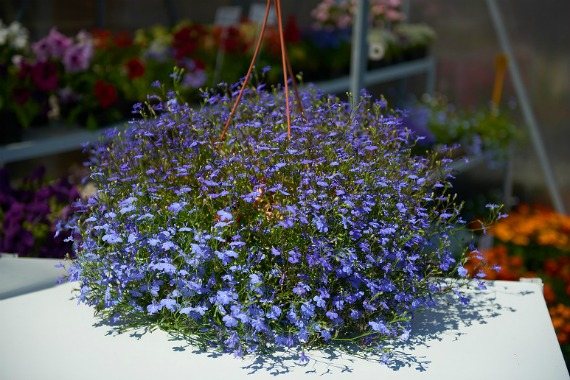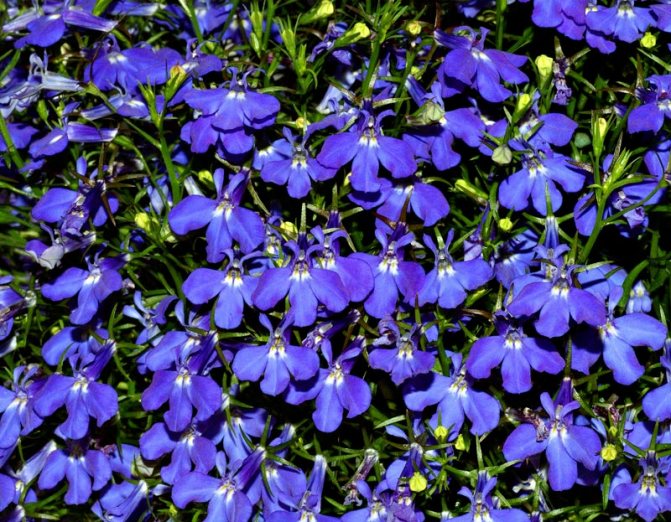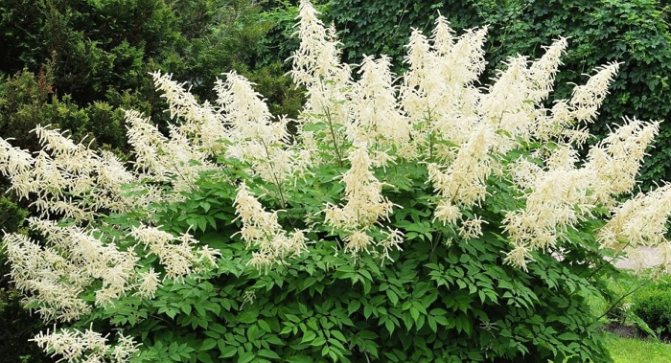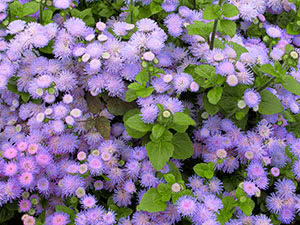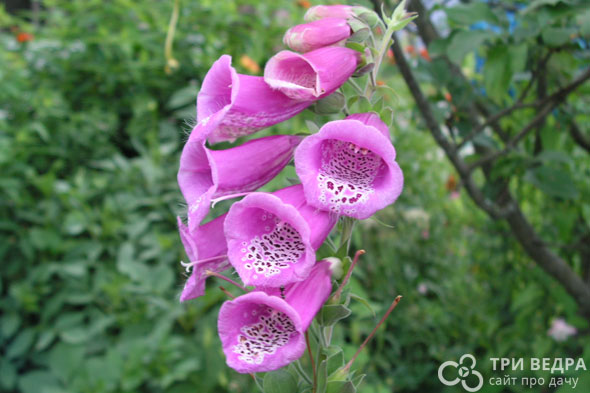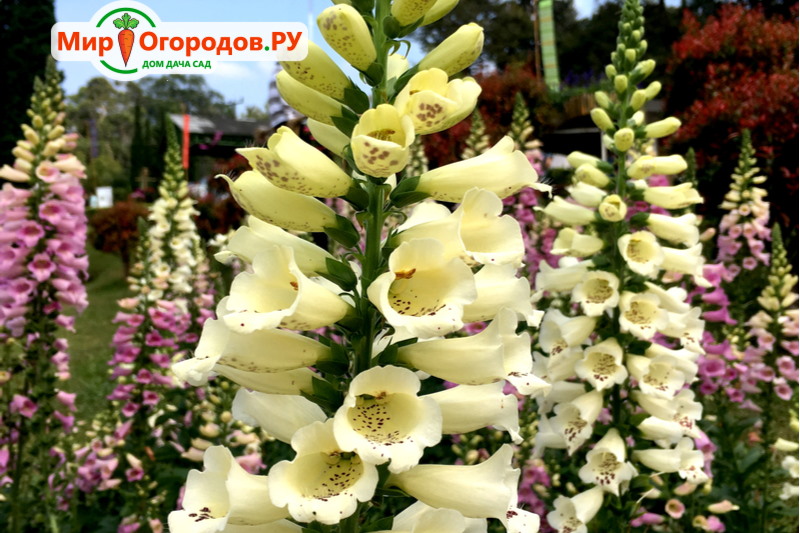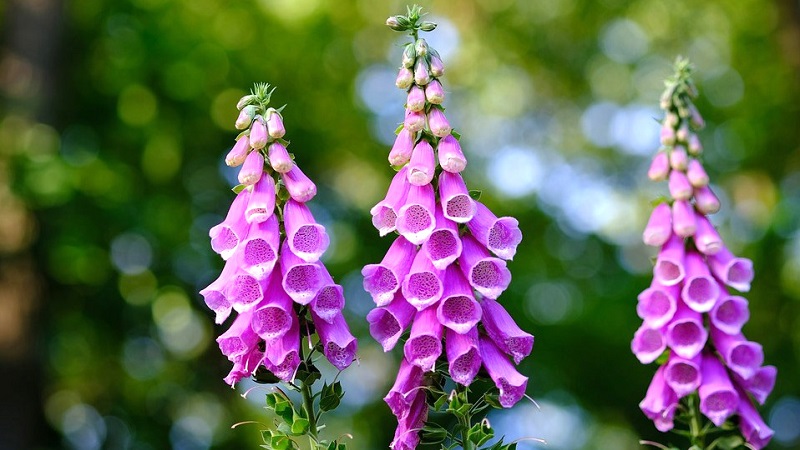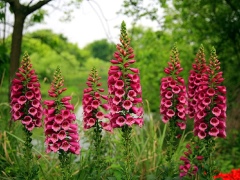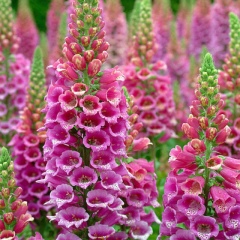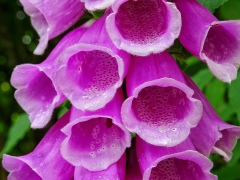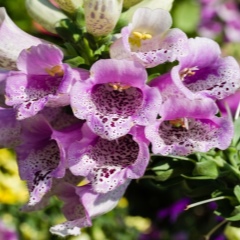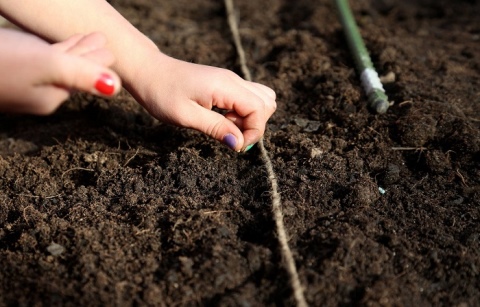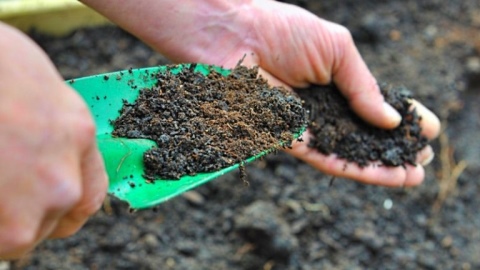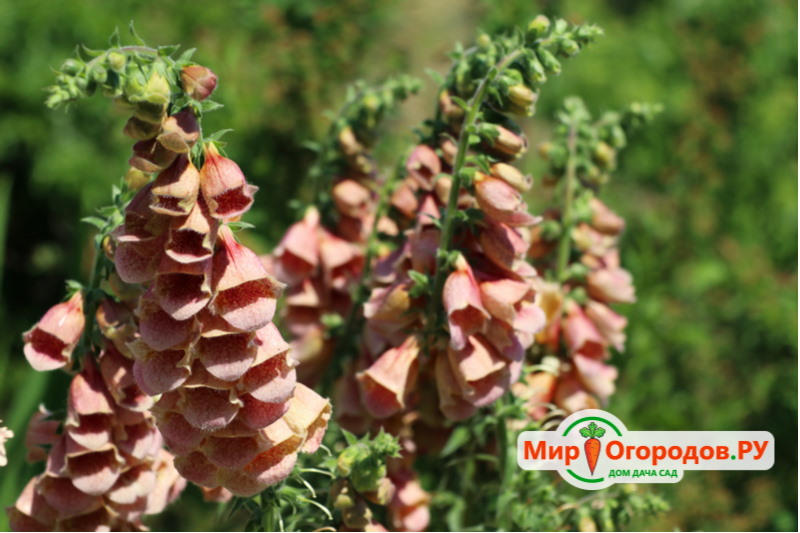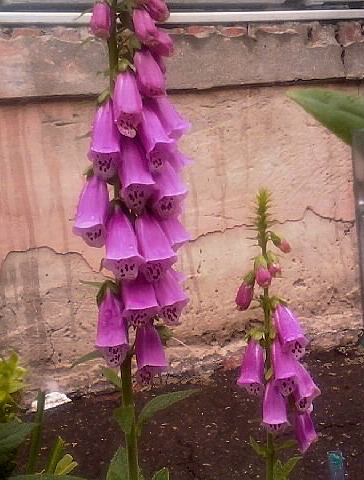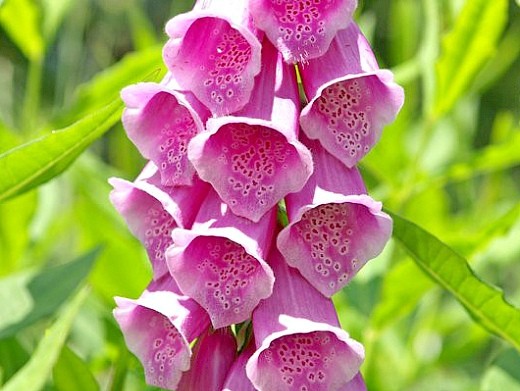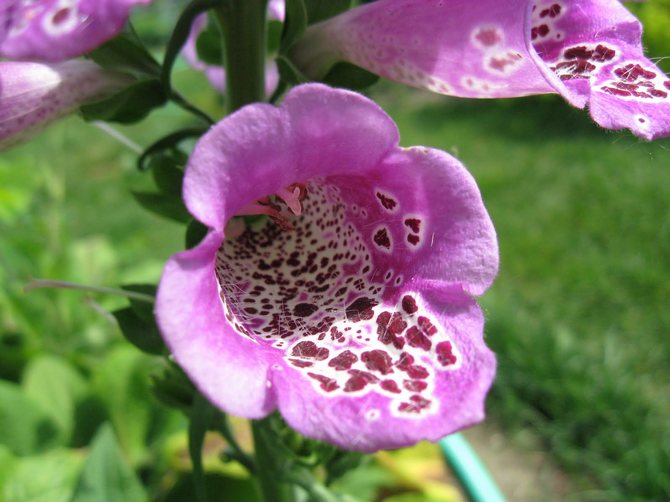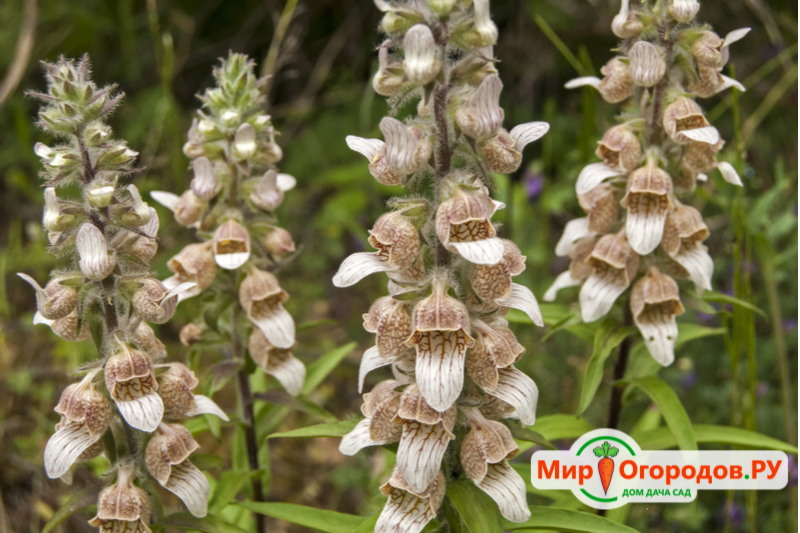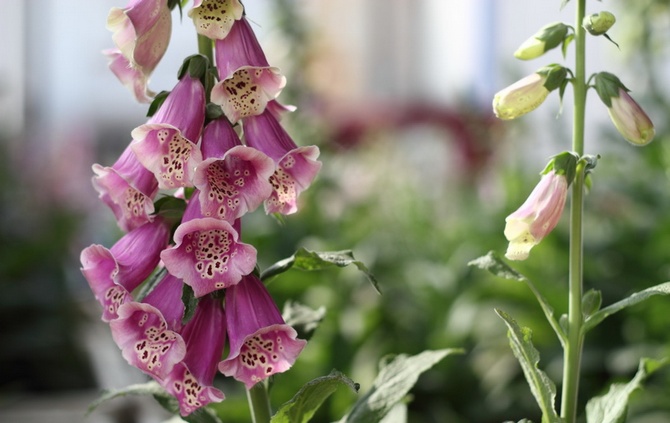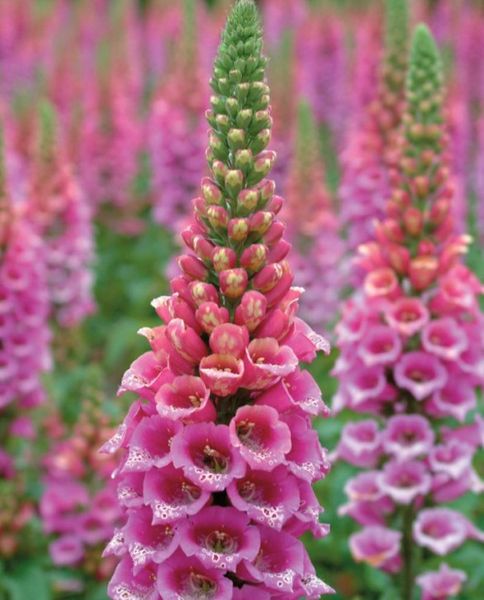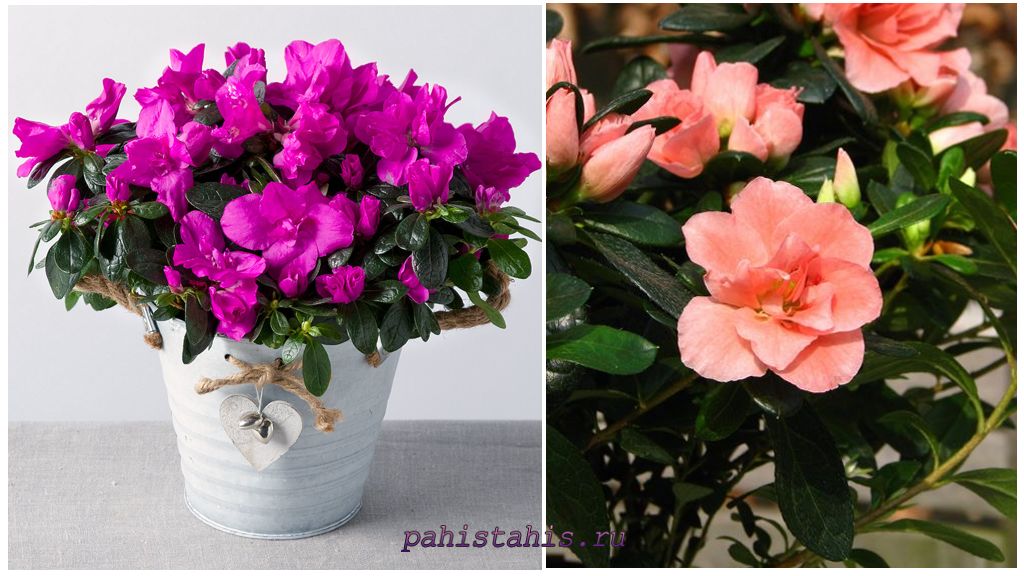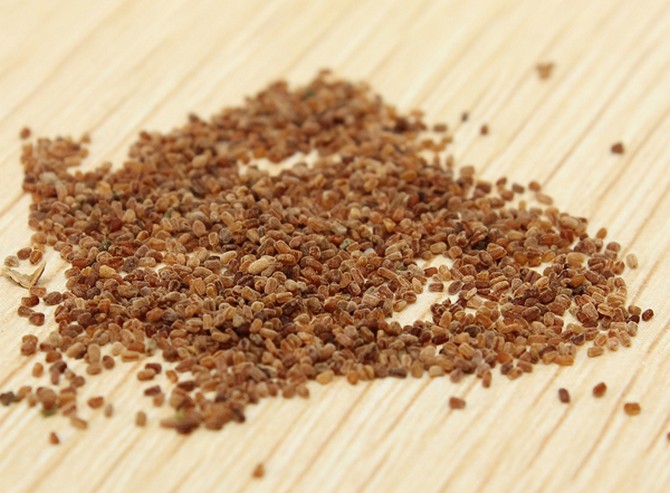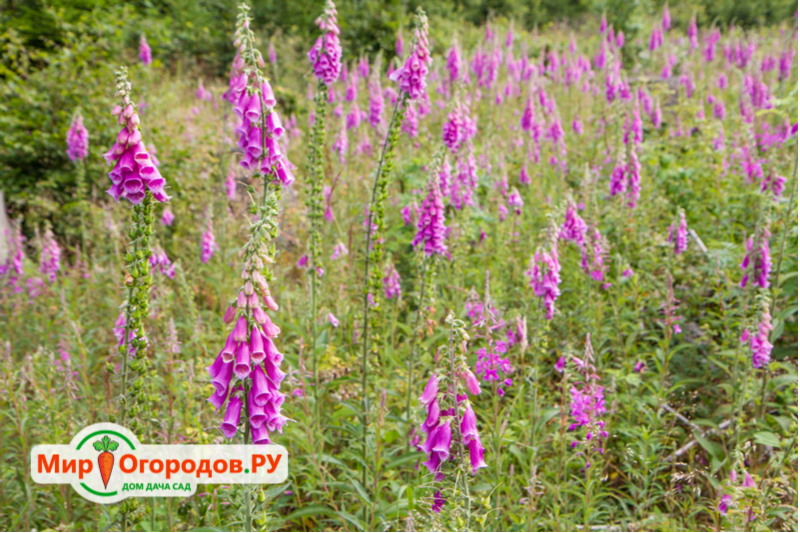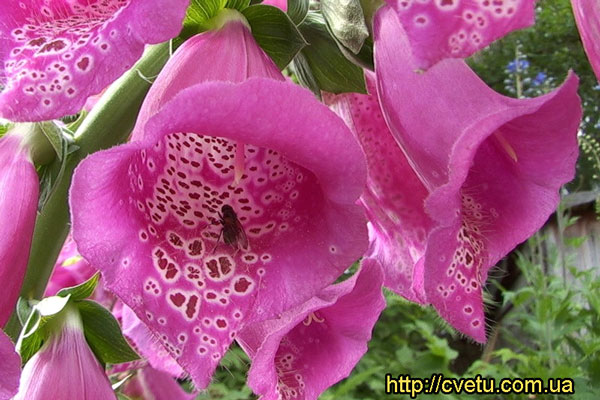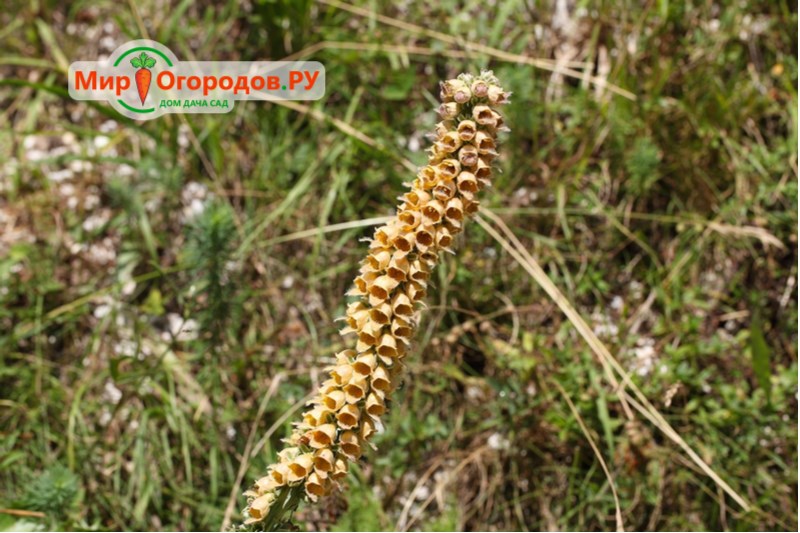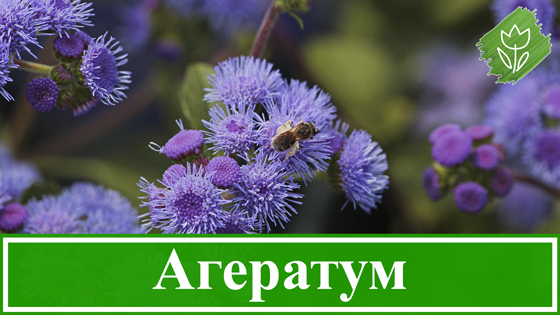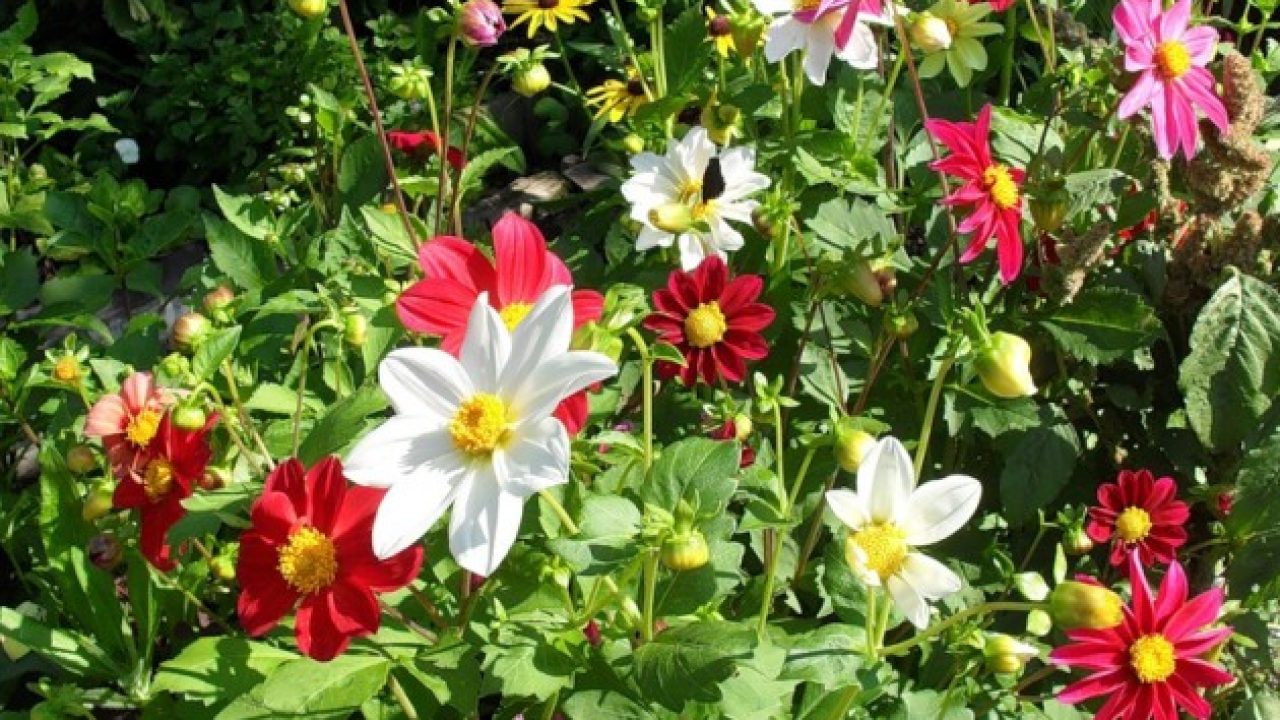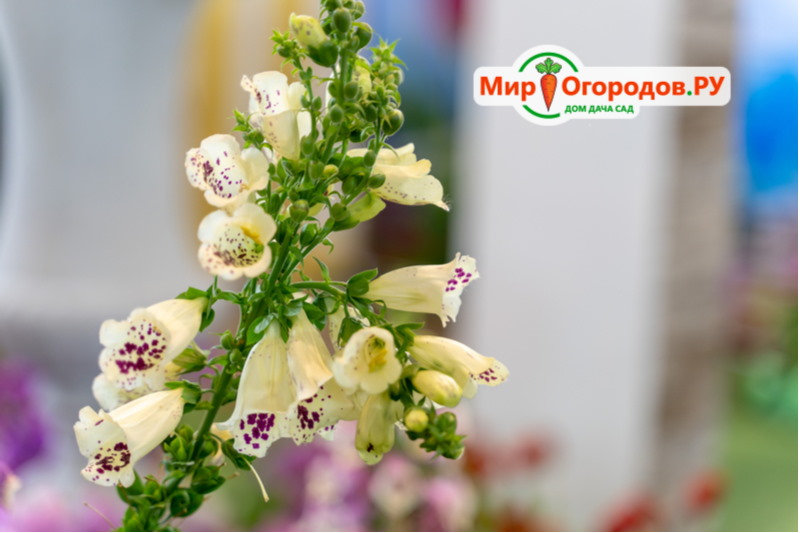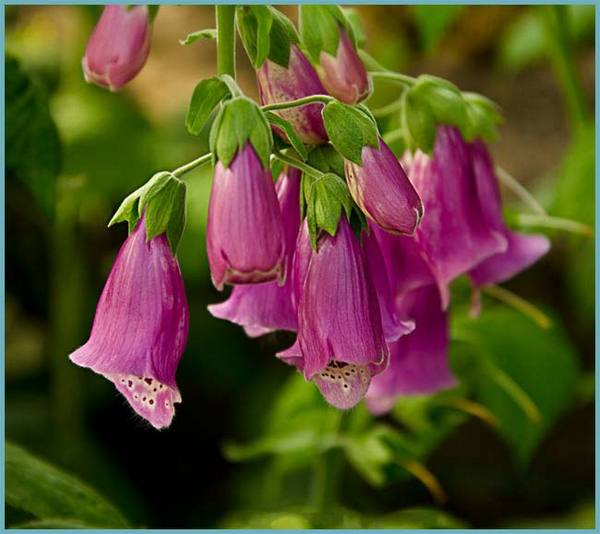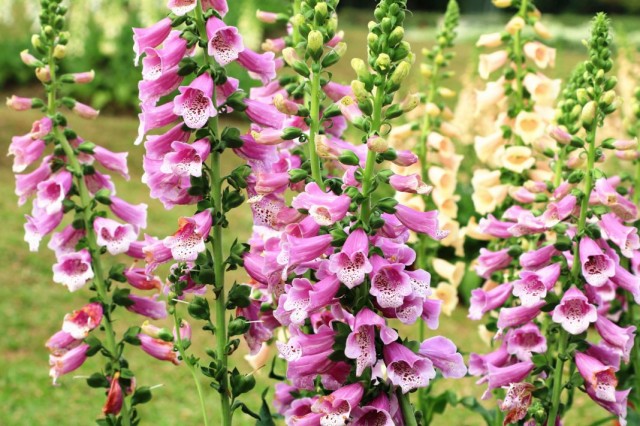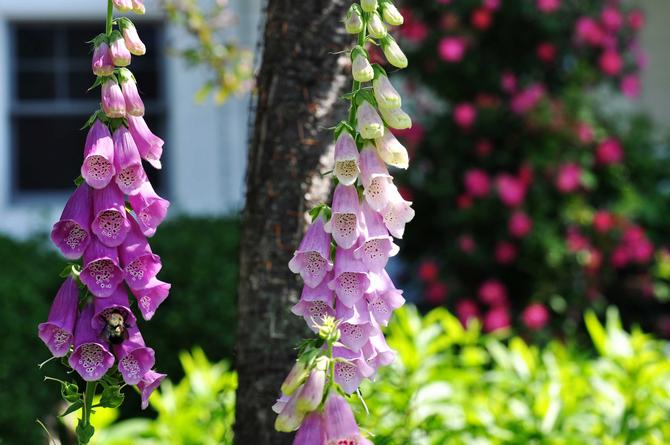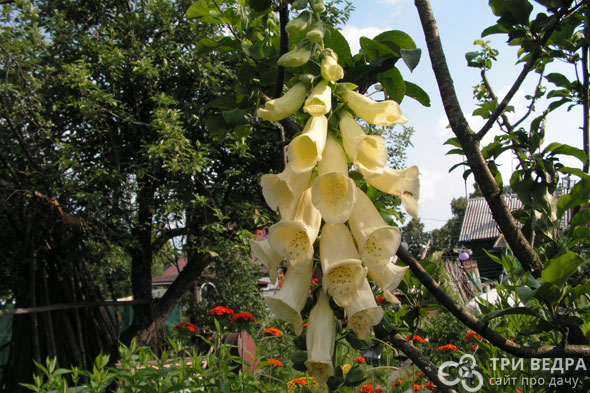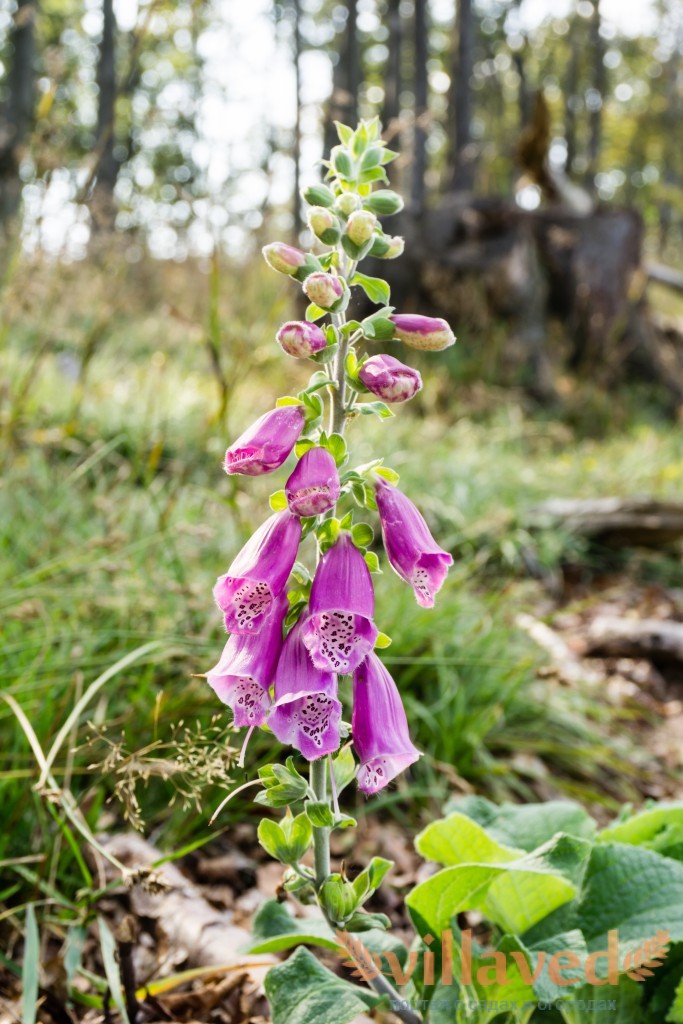Digitalis in landscape design
The plant looks great both in single and in group plantings. Different varieties can be planted on one flower bed, choosing them according to the color scheme. However, it should be borne in mind that insects will cross-pollinate, as a result of which the purity of the variety will be compromised.
Digitalis: different varieties and photos
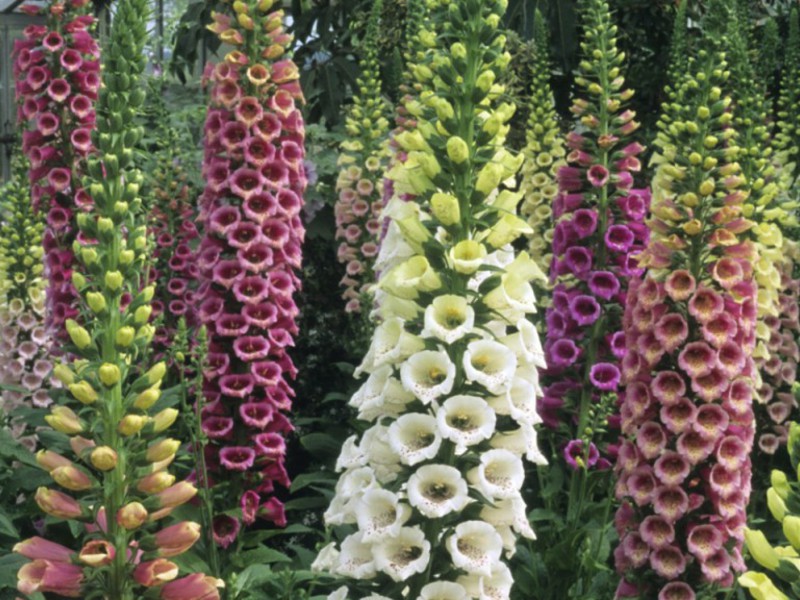
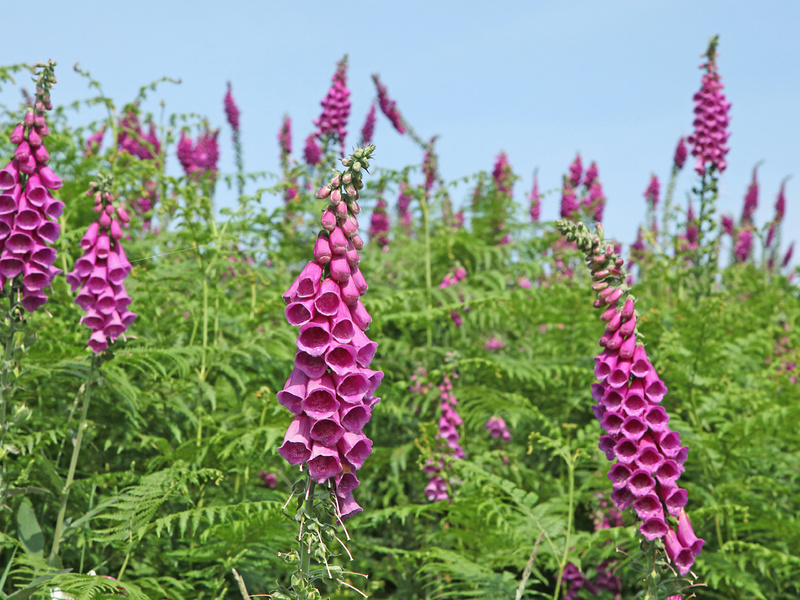


A flower garden of tall plants with digitalis, peonies, valerian, and roses planted in it looks beautiful. Bright tall candles can be used to create a backdrop for lower plants. The foxglove will look spectacular against the background of the building wall contrasting in color. It should be borne in mind that the plant is poisonous, so it cannot be planted in childcare facilities.
Even dwarf varieties are not suitable for decorating a border. But they can be grown in containers, decorating gazebos or verandas. Some varieties stand well in cut and are used for making bouquets.
Planting an unpretentious foxglove in the garden is an excellent alternative to flowering perennials that are demanding to care for. Once grown from seeds, a plant will decorate the site with its bright candlesticks for many years.
Reproduction and care of foxglove
They begin to deal with seedlings from mid-March in order to get material ready for transplantation into open ground by May.
How to grow from seeds
The technique is carried out in several stages:
- The material is pre-soaked in water, changing it every 6 hours. After a week, the seeds will hatch.
- Containers are filled with fertile soil. Seeds are spread over the surface, sprinkled with a thin layer of sand.
- The container is covered with glass or film to create a greenhouse effect, and removed to a warm, bright place. The light should be dim, diffused. Seedlings will appear in two weeks.
- As soon as the first leaves are formed, a pick is made into separate containers (it is better to use peat cups). You can transplant all the shoots into a spacious container, keeping a distance of 10 cm.
- Seedlings are watered as the soil dries up, then loosened. The sprouts protect against drafts.
- For 15 days before disembarking in open ground, hardening is carried out - the containers are taken out into the open air, every day slightly increasing the duration of the procedure. At the end of hardening, it is advisable to bring the period of stay on the street to a whole day.
 Growing herbaceous perennial from seeds
Growing herbaceous perennial from seeds
They are engaged in planting when 5-6 full-fledged leaves are formed on the seedlings. The land on the site should warm up. The process is no different from planting seed. Peat cups are dug into the soil entirely. Upon completion, the crops are watered abundantly, the soil is rammed. A rosette of leaves is formed in the first year after planting. Expect flowering by next season.
Reproduction by shoots
The vegetative method is also suitable. The procedure is carried out in several stages:
- Withering brushes are cut from all stems, leaving only the most blooming ones in order to get seed material from them.
- Three weeks later, young basal shoots should appear at the base of the peeled shoots.
- You need to wait until 7-8 leaves are formed on them, after which the processes are cut off and transplanted to a new place.
Until the fall, they will take root and easily endure the winter. In the spring, flowering stems will form.
 Perennial foxglove can be propagated vegetatively
Perennial foxglove can be propagated vegetatively
Watering and feeding
Foxglove is unpretentious. She does not need daily watering, it is necessary to moisturize only in severe drought. In summer, morning dew and regular rainfall are enough. Each time after rain or watering, the soil at the roots is loosened to a shallow depth.
Top dressing is applied 1-2 times, using complex mineral fertilizers, but always liquid, for which the drug is mixed with water, which is poured over the soil.
Pruning and replanting
The flowering season can be extended by increasing the splendor of the bushes. To do this, you need to periodically pick off fading flowers and fading shoots.
It is easy to transplant digitalis - its root system is located almost horizontally, therefore it is quickly removed from the ground. Transplant is performed according to the rules:
- a pit is prepared in advance, the dimensions of which should be slightly larger than the root system;
- the bush is dug out, keeping an earthen lump, transplanted to a new place;
- watered abundantly.
 Faded inflorescences must be cut off
Faded inflorescences must be cut off
Post-flowering care and preparation for winter
Since the roots of digitalis are located close to the surface, with the arrival of autumn, it is advisable to sprinkle the bushes with another layer of soil. The yellowed peduncles are cut off, leaving a root rosette, covered with fallen leaves, sawdust or spruce branches. Young shrubs are covered with waterproof material.
With the arrival of spring, the cover must be removed so that melt water does not accumulate under it.
Author's advice
Digitalis: planting and care
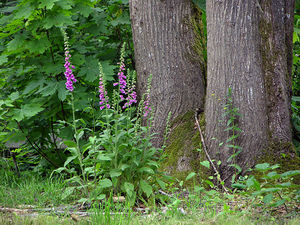 Before planting the bushes, the soil is dug up and enriched with manure or compost and mineral fertilizers. You can use "Nitrofoska" or add 1-2 glasses of wood ash to the holes.
Before planting the bushes, the soil is dug up and enriched with manure or compost and mineral fertilizers. You can use "Nitrofoska" or add 1-2 glasses of wood ash to the holes.
Caring for adult plants is simple. Watering is done only as needed, since the flower does not like excessive moisture. The soil around the bushes should be regularly weeded out and loosened from time to time. The foxglove roots are horizontal, so loosening is done very carefully.
Plant care includes feeding two or three times per season. Special mineral fertilizers are used for flowering flowers. Overfeeding the foxglove is not recommended, otherwise you can get a lush plant without flowers. Faded and wilted flowers are removed from flowering bushes. In this case, flowering will last longer. Inflorescences that have already completely bloomed are cut off.
When caring for foxglove, it is recommended to look at the condition of the roots. By the end of summer, they can crawl out. In the fall, they must be sprinkled with a thick layer of soil, otherwise, in the winter cold, the root system will freeze and the plant will die.
With proper care, seeds will ripen on the plant in the fall. In this case, the adult plant reproduces by self-seeding, which facilitates its reproduction.
Digitalis: planting and care
Before you start growing a plant, you need to understand the peculiarities of planting and growing it.
Seeds
Many growers are engaged in the cultivation of perennial foxglove from seeds. Before planting seeds, you need to prepare for planting. During preparation, you should:
- Choose a suitable time for planting. You need to do this in early March.
- Pick up containers. It is necessary to plant the foxglove in large pots with high-quality drainage.
- Carry out soil preparation. You can plant digitalis in any soil. However, in order for it to bloom in time, it is better to plant it in fertile soil. Therefore, the soil must be fertilized in advance with mineral and organic fertilizing.
- Prepare seed material. All seeds that will be planted in the ground must be germinated in advance. To do this, cover them with a damp cloth for 2-3 days or soak them in a growth stimulator.

Digitalis seeds
After preparation, you can start planting seeds. To do this, pour the fertilized soil into pots and make holes in it 2-3 cm deep. The planted seeds should be watered with warm water and sprinkled with earth. The pot with the planted flowers must be transferred to a sunny windowsill.
Taking care of the planted flowers is quite simple. It is enough to water the seedlings daily with warm water and then loosen the soil. It is not necessary to add additional fertilizing.They are used only after transplanting seedlings.
Important! Seedlings are grown within a month, after which they need to be transplanted into open ground or larger containers. When the first true leaves appear on the seedlings, it can be transplanted to a new place.
To do this, the plant must be carefully removed from the pot and planted in a previously prepared hole. Moreover, its depth should be at least 5 cm so that the root system can fully fit there.
When the first true leaves appear on the seedlings, it can be transplanted to a new place. To do this, the plant must be carefully removed from the pot and planted in a previously prepared hole. Moreover, its depth should be at least 5 cm so that the root system can fully fit there.
Root shoots
Foxglove can reproduce by root shoots. To do this, in early spring, it must be carefully cut and germinated in water. When the sprouted offspring take root, they can be transplanted to a permanent place. It is best to do this in mid-April, when the air temperature will not drop below 10 ° C heat.

Sprouted foxglove
Dividing the bush
Dividing the bushes of digitalis flowers should be done after flowering. To divide the bushes, they must first be carefully dug out of the ground and divided into parts. Then the separated shoots are planted to new places.
Features of care in the garden
Digitalis has a strong immunity to disease. The plant loves loose, well-fertilized soil. In conditions of stagnant water, it can rot and stop blooming.
Note! Since the roots are located close to the surface of the earth, they can become bare by the fall, which will lead to their freezing in winter. If this happens, the root system is sprinkled with an additional layer of earth and tamped
Watering
The plant requires frequent watering, but the water should not stagnate, for this, good drainage in the soil should be foreseen in advance.
Top dressing
Top dressing begins with ammonium nitrate diluted with water in a proportion of 10 g per 10 liters of water. The subsequent ones are carried out with mineral fertilizers 2-3 times per summer.
Transfer
Digitalis has roots located close to the soil surface, so its transplantation does not injure the root system, the plant is easily removed from the ground. It is better to transplant with a lump.
Types and decorative varieties with photos
Gardeners primarily choose crops for their decorative properties. In recent years, picturesque species of foxglove with different colors have been bred. There are 11 species in the genus, some of which are common in our country.
Purple
It is found naturally throughout Europe. Served as the basis for many varieties of purple shades. Grown as a biennial plant. The height of the shoots reaches about 1.5 m. Peduncles are slightly branched, covered with fluff. Foliage is one-sided, elongated. Inflorescences in the form of brushes, length 80 cm, collected from 5 flowers, each 5 cm long. Blooms all summer.
The most popular varieties:
- Shirley - bushes up to 1.5 m, long flowering, purple, pink or cream inflorescences;
- Excelsior - the height of the shoots is 1.8 m, massive flowers are formed in a spiral;
- Pelori - the length of the peduncles reaches 1.8 m, densely covered with large flowers;
- Champagne Rosé is a scenic, one-color look with a height of 1.2 m.
Yellow
Growth area - South-Western Europe. Tall shrub, shoot height up to 80–100 cm. Foliage and peduncles are not pubescent. The buds are yellow, up to 2.5 cm long. The beginning of flowering is July. The most famous variety of the species is Gelb Janus.
Large-flowered
Growing area: Western Europe, Ukraine, the European part of Russia, Southwest Siberia. Tall, shoots up to 1.2 m. The foliage is covered with terry along the vein and border. The buds are massive, up to 6 cm, painted in spectacular yellow tones. Slightly velvety outside, with brown veins inside the corolla.
Rusty
Named for the reddish tint of the corollas.It is less common than purple or large-flowered, but it has many fans among Russian summer residents. Perennial, has medicinal properties.
The bush is tall (70–120 cm), some specimens reach 2 m. The foliage is bare or slightly velvety, elongated, pointed. The flowers are small, up to 4 cm, similar in shape to orchids. The colors are grayish-yellow, brown, yellow with a pink tint. The corollas are decorated with purple or dark red veins inside. Vegetation period: mid-June - August.
Woolly
The view is inconspicuous, common in Moldova. The stalk, upper foliage and calyx are covered with thick pile, which is the reason for the name of the species. Stems are solitary, small dark yellow flowers with purple veins are formed at the ends. Flowering begins in July and lasts a month and a half. Woolly foxglove is widely used in folk medicine.
Merton
Perennial, bred on the basis of purple and large-flowered species. Shoots reach 80 cm. Flowers are reddish, strawberry-colored, with dark spots. It blooms early, in May - early June.
Description of foxglove
Purple foxglove is a very impressive tall plant with many wonderful varieties and forms. Plant height from 60 cm to a meter in a favorable year. The beginning of the first year of flower life is marked by the appearance of a dense, strong rosette of rough large leaves, pubescent below. The upper leaves are sessile, and the lower ones are long-elliptic in shape.
An unbranched flowering stem emerges from the center of the leaf rosette, on which there is a pyramidal inflorescence - a one-sided ear, on which numerous large flowers of an irregular bell-shaped shape, resembling a thimble, are located, of various colors: purple, white, lilac, mainly with dark dots on the inner surface corolla. Uniformly colored are much less common.
The most common variety of foxglove purpurea has a long spike of large pink-purple flowers with dark brown dots inside. Such foxglove feels better in sunny areas of the cottage, although it grows well in the shade. It is not very demanding on the ground, but for its better development, fertile soils are needed - loose and moderately moist, but not damp.
A less common but more spectacular plant variety called gluxinoides or gloxineflora has a long, dense spike of very large flowers with bright pink, white, lilac or cream and their shades. Luxurious spotted foxglove is also very valuable. It is a gigantic form with spotted flowers of various shades. The bell-shaped variety has inflorescences of large flowers of the same shape. The monstrose variety (amazing) has double apical flowers.


